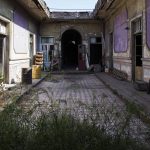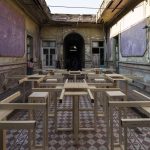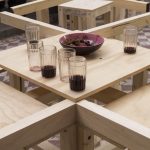December 2015
The work first takes place at Compañia de Jesus; a quiet, shady street in the neighborhood of Yungay, dos mil ochocientos cincuenta, where worn-granite steps lead up to carved-oak doors that open onto a long entrance hall that spills into a bright-open courtyard that gathers into a dark-vaulted passageway that lets into a big-overgrown garden surrounded by high-stone walls. The courtyard and corridors are paved with red and white geometric tile; are lined on both sides with tall-paneled doors, each guarding an empty room with ornate falling-ceilings and gaping-parquet floors stashing litter and junk, piles of waste from years of human and other animal invasions. We pool in the red & white courtyard where weeds, three feet tall, grow through the cracked tiles. We begin our work. We cut the weeds, sweep the floors. On our hands and knees, we scrub the tiles for many hours under the hot sun.

The pleasure of the work is to observe the combination of order and disorder, contraction and release in orchestrated social interactions. Responding to spatial delimitations and behavioral directives, participants negotiate between instinct and instruction, flow and form. The result is a harmonizing of collective, coordinated cooperation with arbitrary but intimate inter-individual exchanges. The arena for the work is the red-and-white tiled floor of the interior courtyard, upon which the 8 cross-shaped, counter-height tables are set in a tessellating pattern, each leaving 4 clearly delineated negative spaces, compartments neatly suited to the volume of an individual body. When the work begins, the participants in place are directed to interact exclusively with 1 table-mate at a time, alternating partners during 4 short, consecutive episodes, according to the prescribed sequence of configurations. We refer to the work as a dance because of the formally established interaction and sustained 1‑on‑1 engagement that occurs in timed intervals, analogous to dancing with one partner for the duration of 1 song.
We bring in our furniture: eight cross-shaped tables, counter-height, and eight narrow stands, all crudely made of pine lumber. The tables are made of two intersecting sets of long, parallel strips topped with a small-central plywood square. The square-cross creates four right angles, providing four half-squares of negative space; each a nook for a single body to fill comfortably, enjoying a reasonable range of movement, to lean in, lean out, pivot…etc.
The tables are arranged in a staggered grid, with two outer rows of three tables and a center row of two. The stands are distributed evenly among the tables in equidistant intervals.
A large bowl of red grapes is placed at the center of each table and a glass of red liquid is placed at each individual setting.

All participants have equal status, and all categories of participation and positions on the floor are determined by chance.
The participants arrive and form a line at the door for check-in and place assignment.
Plucking a folded paper out a hat, the participants are assigned their position according to the coordinates of their table and slot. Some are randomly selected as musicians. The rest are dancers. When it is time, they all take their positions on the floor.
4 per table x 8 tables = 32 dancers plus 6 pre-selected guides positioned in an even pattern among the tables. Plus, on the edge of the floor, a cluster of 5 musicians with handheld percussion instruments. There are 4 dances, each with a duration of 5 minutes, plus a 1‑minute interval between each one.
First Dance is the longitudinal intra-table relation (“A”s with “B”s and “C”s with “D”s)
Second Dance is the lateral intra-table relation (“A”s with “C”s and “B”s with “D”s)
Third Dance is the diagonal intra-table relation (“A”s with “D”s and “B”s with “C”s)
Fourth Dance is the diagonal inter-table relation (only the interior column (“A”s with “D”s and “B”s with “C”s) pivot to face each other while all other dancers take one step backwards to line the perimeter of the floor).
After the 4 dances are completed, the participants are released from their positions and are able to move about the floor freely.
Glasses are emptied and cleared as just night falls into the courtyard.
Obs.: The constraints of the format produce an energetic side-effect. In compliance with the imposed structure, individuals are incited to forge a spontaneous complicity in a way that does not easily occur in everyday life. The collective experience – the whole group repeating the same action simultaneously – enhances the individual exchange by giving it contextual validation and amplification.
